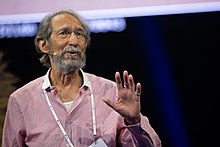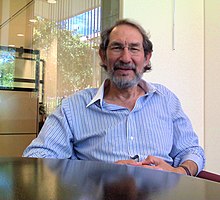The metabolic theory of ecology (MTE) is the ecological component of the more general Metabolic Scaling Theory and Kleiber's law. It posits that the metabolic rate of organisms is the fundamental biological rate that governs most observed patterns in ecology. MTE is part of a larger set of theory known as metabolic scaling theory that attempts to provide a unified theory for the importance of metabolism in driving pattern and process in biology from the level of cells all the way to the biosphere.
James Hemphill Brown is an American biologist and academic.

Kleiber's law, named after Max Kleiber for his biology work in the early 1930s, states, after many observation that, for a vast number of animals, an animal's Basal Metabolic Rate scales to the 3⁄4 power of the animal's mass.

Allometry is the study of the relationship of body size to shape, anatomy, physiology and behaviour, first outlined by Otto Snell in 1892, by D'Arcy Thompson in 1917 in On Growth and Form and by Julian Huxley in 1932.
Alkane metathesis is a class of chemical reaction in which an alkane is rearranged to give a longer or shorter alkane product. It is similar to olefin metathesis, except that olefin metathesis cleaves and recreates a carbon-carbon double bond, but alkane metathesis operates on a carbon-carbon single bond.
The dynamic energy budget (DEB) theory is a formal metabolic theory which provides a single quantitative framework to dynamically describe the aspects of metabolism of all living organisms at the individual level, based on assumptions about energy uptake, storage, and utilization of various substances. The DEB theory adheres to stringent thermodynamic principles, is motivated by universally observed patterns, is non-species specific, and links different levels of biological organization as prescribed by the implications of energetics. Models based on the DEB theory have been successfully applied to over 1000 species with real-life applications ranging from conservation, aquaculture, general ecology, and ecotoxicology. The theory is contributing to the theoretical underpinning of the emerging field of metabolic ecology.
The Womersley number is a dimensionless number in biofluid mechanics and biofluid dynamics. It is a dimensionless expression of the pulsatile flow frequency in relation to viscous effects. It is named after John R. Womersley (1907–1958) for his work with blood flow in arteries. The Womersley number is important in keeping dynamic similarity when scaling an experiment. An example of this is scaling up the vascular system for experimental study. The Womersley number is also important in determining the thickness of the boundary layer to see if entrance effects can be ignored.

The Department of Physics and Astronomy at the University of Manchester is one of the largest and most active physics departments in the UK, taking around 330 new undergraduates and 50 postgraduates each year, and employing more than 80 members of academic staff and over 100 research fellows and associates. The department is based on two sites: the Schuster Laboratory on Brunswick Street and the Jodrell Bank Centre for Astrophysics in Cheshire, international headquarters of the Square Kilometre Array (SKA).

Evolutionary physiology is the study of the biological evolution of physiological structures and processes; that is, the manner in which the functional characteristics of organisms have responded to natural selection or sexual selection or changed by random genetic drift across multiple generations during the history of a population or species. It is a sub-discipline of both physiology and evolutionary biology. Practitioners in the field come from a variety of backgrounds, including physiology, evolutionary biology, ecology, and genetics.

Tumor necrosis factor receptor 1 (TNFR1), also known as tumor necrosis factor receptor superfamily member 1A (TNFRSF1A) and CD120a, is a ubiquitous membrane receptor that binds tumor necrosis factor-alpha (TNFα).

BAFF receptor, also known as tumor necrosis factor receptor superfamily member 13C (TNFRSF13C) and BLyS receptor 3 (BR3), is a membrane protein of the TNF receptor superfamily which recognizes BAFF, an essential factor for B cell maturation and survival. In humans it is encoded by the TNFRSF13C gene.

Lysine-specific demethylase 5A is an enzyme that in humans is encoded by the KDM5A gene.

Dynein light chain 2, cytoplasmic is a protein that in humans is encoded by the DYNLL2 gene.

Fractal analysis is assessing fractal characteristics of data. It consists of several methods to assign a fractal dimension and other fractal characteristics to a dataset which may be a theoretical dataset, or a pattern or signal extracted from phenomena including topography, natural geometric objects, ecology and aquatic sciences, sound, market fluctuations, heart rates, frequency domain in electroencephalography signals, digital images, molecular motion, and data science. Fractal analysis is now widely used in all areas of science. An important limitation of fractal analysis is that arriving at an empirically determined fractal dimension does not necessarily prove that a pattern is fractal; rather, other essential characteristics have to be considered. Fractal analysis is valuable in expanding our knowledge of the structure and function of various systems, and as a potential tool to mathematically assess novel areas of study. Fractal calculus was formulated which is a generalization of ordinary calculus.

Stuart Leonard Pimm is the Doris Duke Chair of Conservation Ecology at Duke University. His early career was as a theoretical ecologist but he now specialises in scientific research of biodiversity and conservation biology.

Allometric engineering is the process of experimentally shifting the scaling relationships, for body size or shape, in a population of organisms. More specifically, the process of experimentally breaking the tight covariance evident among component traits of a complex phenotype by altering the variance of one trait relative to another. Typically, body size is one of the two traits. The measurements of the two traits are plotted against each other and the scaling relationship can be represented as: . Manipulations of this sort alter the scaling relationships either by shifting the intercept (b), slope (m) or both to create novel variants (see: Allometry, for more details). These novel variants can then be tested for differences in performance or fitness. Through careful testing, one could sequentially test each component of a trait suite to determine how each part contributes to the function of the entire complex phenotype, and ultimately the fitness of the organism. This technique allows for comparison within or among biological groups differing in size by adjusting morphology to match one another and comparing their performances.
Brian Joseph Enquist is an American biologist and academic. Enquist is a professor of biology at the University of Arizona. He is also external professor at the Santa Fe Institute. He is a biologist, plant biologist and an ecologist. He was elected as a Fellow of the American Association for the Advancement of Science (AAAS) in 2012 and the Ecological Society of America (ESA) in 2018.
Biomass allocation is a concept in plant biology which indicates the relative proportion of plant biomass present in the different organs of a plant. It can also be used for whole plant communities.
Urban scaling is an area of research within the study of cities as complex systems. It examines how various urban indicators change systematically with city size.
Luís M. A. Bettencourt is a physicist, urban and complex systems researcher, author and academic. He is a Professor of Ecology and Evolution and the College at the University of Chicago as well as an Associate Faculty of the Department of Sociology and External Professor at the Santa Fe Institute.












